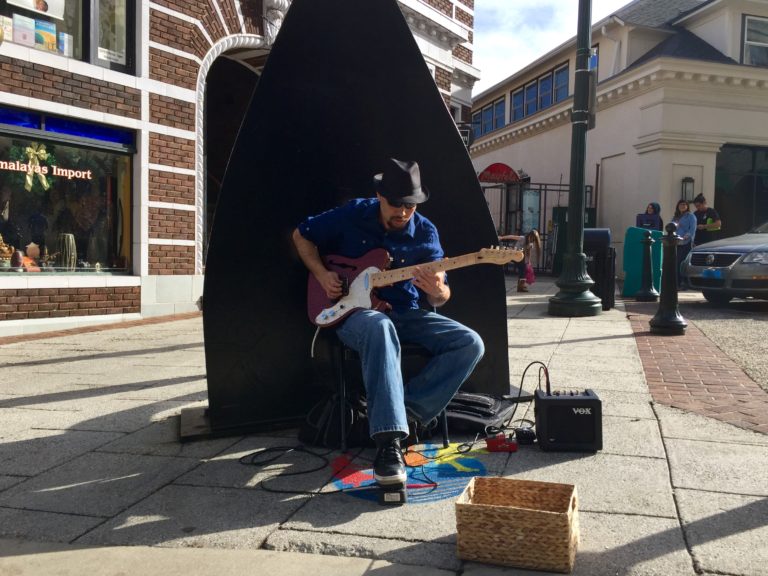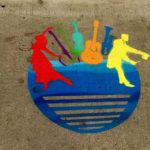Asheville guitarist Adi grooves at the Flat Iron sculpture, one of two high-impact areas identified for the City’s street performers pilot program.
From string bands to celestial hammered dulcimer sounds, music emanates from many downtown Asheville sidewalks. So much so, Asheville’s street performer scene is part of our brand as a city.
Now a new brochure titled “Street Performers” provides a guide to the creative community taking it to the street with their music, their art in many forms. The guide includes not only regulations for performing on the City’s sidewalks, but also street performer etiquette from the Asheville Buskers Collective.
This brochure represents part of a two-year community conversation that resulted in not only crafting these guidelines but also the creation of a busking pilot program that incorporates two “high-impact” performance areas.
“The Asheville Buskers Collective has worked to help create positive changes to the City’s busking policy. With a lack of good working models to borrow from, it was up to us to create policy that works for Asheville,” said Andrew Fletcher, advocate for the Asheville Buskers Collective. “Creating a relationship between policy makers and street performers has led to an approach that recognizes the cultural and economic value of having thriving sidewalk entertainers, while acknowledging the issues that arise from crowds and noise.”
How we got here
As Asheville’s busking community grew, crowds spilled over into streets at times, posing hazards. Downtown merchants took issue with some performers blocking access to their businesses. Requests for guidelines followed, so the City undertook a two-year community conversation on public space management and place-making downtown.
Those conversations included street performer input from Asheville Buskers Collective as well as downtown merchants, residents and Asheville Police. The conversations focused on how to balance Asheville’s vibrant street performance scene with common sense safety, while respecting downtown businesses and residents.
It was uncomfortable at times, with musicians concerned about overbearing rules. The issue went before Asheville’s Public Safety Committee several times, where tough questions were asked on all sides. Important to the street performers was that busking policy was differentiated from a panhandling policy.
The pilot program
The two high-impact areas identified for the pilot program include around the Flat Iron sculpture on Wall Street at Battery Park Avenue and the Haywood Street sidewalk in front of Woolworth Walk. At these spots only 1 performer or group can perform at a time within 120 feet. Non-audible performances, such as mimes, are allowed within 40 feet. A 6-foot pathway must be kept clear for safe pedestrian traffic.
Violators can face a fine up to $50, not including court costs, though the idea is to issue warnings first to bring performers into compliance.
Other popular busking spots are not affected by these rules per se, but they are good guidelines overall.
Best of all the rules outlined in the brochure create a path forward for productive coexistence between downtown performers, pedestrians and merchants.
“With support from downtown stakeholders, City staff and the Asheville Police Department, we’re confident that Asheville’s busking culture is a sustainable part of downtown life,” said Fletcher.
Development of the busking pilot program was guided by the Public Safety Committee and approved unanimously by City Council on October 25, 2016.
Where to find the brochure
A copy of the new Street Performers brochure is available on the City of Asheville website
Find physical copies at the Pack Square Park Pavilion, at the Asheville Downtown Association’s brochure rack and at Asheville City Hall. Look for them soon at the Asheville Visitors Center. Members of the Asheville Buskers Collective also have copies to pass out to local and visiting street performers.

